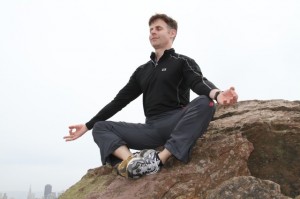Ken Breniman is a yoga therapist based out of San Francisco. His studio focuses on classes specifically designed to those with physical impairments, and those grappling with difficult emotions, which oftentimes become one and the same. He teaches a special course called Yoga for Grief. He sat down with SevenPonds, and told us a little about what he does.
Antal: Could you tell our readers a little about Yoga for Grief and about yourself?
Ken: I’m a yoga therapist. That’s a pretty vague term, but generally it means that I come from a background in mental health. This informs my teaching practice, and I also offer one-on-one, individual yoga therapy sessions. In Yoga for Grief I use yoga as a supply method to the grieving process, to help people get in touch with their thoughts and emotions through their bodies, something that traditional grief counselors don’t do. At the beginning of the class we have a brief check in, where we decide what we want to accomplish with the session. Then we do physical movements, some of which are inspired by yoga, such as the sun salutations, but we try to add in the intention that the motions are going to be used with the breath. Gives the grieving mind and heart some kind of ritual to work through, moving with the breath, moving out of grief and sadness. Then we move into more gentle, restorative practices, slow stretches with blocks and such, then in the final phase we bring in an acupuncturist. Acupuncture really helps feelings come to the surface, a process called Yoga Nidra, a sort of full body scan, what yogis call a wakeful sleep. This state of mind really lets us interact with our emotions, and lets them subside. That’s the last phase, and then we wrap up with another check in.
Antal: What interests you about therapeutic yoga? Why did you decide on this particular practice?
Ken: When I was eighteen I lost a parent. I didn’t have yoga back then, and whether you’re taking two classes or not, learning how to deal with this stuff, it makes a big difference. I would like to provide for others what I did not receive myself.
Antal: And that informed your practice later?
Ken: Exactly. For a while I was doing Ananda Seva Mission in Santa Rosa, and some presenters came through discussing yoga for different mental or physical health work. I started speaking with one of them, and I guess I just sort of perceived it to be what the community might need. And I’m still learning, the practice is still evolving. It’s always a work in progress. We try different things in different workshops, different therapy sessions. In the workshops it’s usually a small group of 10 – 12 people. Those that shared with me are already aware that grief within their bodies is affecting them physically, getting in the way of their ability to keep up with pre-existing conditions and concerns in the world. The motivation is to get them out of whatever they are stuck in, to help people realize that mind-body-heart connection, the strength of our relaxation response as opposed to the knee jerk fight or flight. Once people have a taste of that, they usually want more.
Antal: Are there any time where you wouldn’t recommend yoga as a facilitator of healing?
Ken: That’s an important consideration. We require a doctor’s clearance to be able to exercise, but we also use our own discretion. One patient couldn’t go through the class even though the doctor said she was physically able, so we recognized this, and stopped early. There are emotional considerations as well. Sometimes people aren’t ready to fully engage with what they’re going through. There’s an interesting phenomenon that I’ve noticed — the people who register for yoga for grief early on are more likely to drop out than those who register later. They arrive at some other place in the meantime, either they don’t feel that they are ready for the course, or they find some other outlet. I try not to hold those people responsible, because I understand that a lot of people are dealing with their own aging or dying process. I trust that those who pull back have their own good reasons. And you know what, a lot of people come back anyways.
Antal: Thanks so much for speaking with us, Ken. Keep up the good work.
Ken: No problem, and thanks for spreading our message out there.
- Read how kayaking helped one person navigate their grief
- Learn about Susan Braun’s healing community of Common Weal
- Peruse SevenPonds’ library of healing film reviews, to find the perfect one for you at the time that you need it

 How to deal with Grief? – An Interview with Ken Breniman
How to deal with Grief? – An Interview with Ken Breniman




 Forest Bathing Eases Grief by Soaking in Nature
Forest Bathing Eases Grief by Soaking in Nature
 The Spiritual Symbolism of Cardinals
The Spiritual Symbolism of Cardinals
















Ken’s comment about those who come to his class early tend to drop out is helpful to why I’m unable to get myself around people. I have such a need to grieve and be alone. I have been encouraged by friends to go to a drop-in support group but I’m just not ready. Life just does not feel the same to me right now. I just take one day at a time and hope to be ready soon. Reading that alleviated some worry.
Report this comment
I had no idea yoga could be applied to the grieving process. Leave it to your website to find such an authentic method.
Report this comment